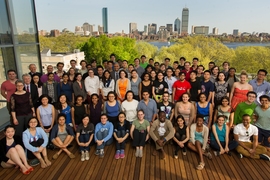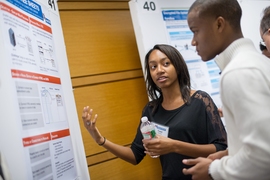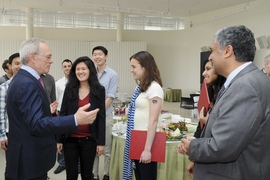Ian A. Waitz, dean of the School of Engineering, officially welcomed 183 students into the 2015-2016 SuperUROP class on Thursday, Sept. 30, at a Stata Center reception for participants in the program, which has more than doubled in size since its 2012 launch within the Department of Electrical Engineering and Computer Science (EECS).
Opened for the first time this year to students throughout the School of Engineering, the Advanced Undergraduate Research Opportunities Program — commonly known as SuperUROP — is a yearlong independent research program that builds on the success of MIT’s Undergraduate Research Opportunities Program (UROP). SuperUROP’s additional goals include requiring students to take a two-term course on undergraduate research and to produce prototypes or publication-worthy results.
“SuperUROP is a great opportunity to go into depth on a topic over a year and have some structure,” Waitz told this year’s new SuperUROP students. “I hope you have fun with it — I know the people before you did.”
Waitz, the Jerome C. Hunsaker Professor of Aeronautics and Astronautics, said the School of Engineering provided support for the program’s expansion this year because the numbers of students participating through EECS showed a high level of interest. “Students have been voting with their feet,” he said after the event. “The participation was already there, and when you talked to the ones who had done it, they really loved the experience it gave them.”
SuperUROP has grown every year since it began with 86 participants, all of whom were in EECS. This year, 183 students have signed up from seven departments: Aeronautics and Astronautics (AeroAstro); Biological Engineering; Chemical Engineering; Civil and Environmental Engineering; EECS; Mechanical Engineering; and Nuclear Science and Engineering.
“The expansion of the SuperUROP program across the School of Engineering will enable our students to learn about a broad range of research directions,” said Anantha P. Chandrakasan, the Joseph F. and Nancy P. Keithley Professor of Electrical Engineering and head of EECS. “This year’s class is our biggest yet, and they are already making significant progress in formulating their research projects and technical approaches. I look forward to following their impactful research over the academic year.”
Students attending the reception described working on a wide range of projects from machine learning to electrospray micro-thrusters and from cybersecurity to concussion-prevention football helmets. “SuperUROP is about really making a contribution to what’s already out there, which is super cool,” said Skanda Koppula, a junior in EECS who is trying to develop a chip capable of speaker authentication. “There’s a lot of emphasis on the project being pioneering in the field.”
Designed for students who have already completed a UROP and who want to advance to graduate-level research, SuperUROP requires more independence — which students say they like. “You’re not a code monkey or a lab lackey. You are calling the shots with your own project,” said Kaustav Gopinathan, a senior in EECS who participated in the SuperUROP program last year and offered remarks at the reception.
“I feel like we’re treated as grad students. There are tons of resources and plenty of access to the professor,” said Julia CrowleyFarenga, a senior in AeroAstro who is working on a football helmet.
Focusing on a project for a full year is a major advantage of the SuperUROP, students said. “You don’t have to rush,” explained Berj Chilingirian, a senior in EECS and mathematics working on a hardware extension for improved computer security. “Really technical problems require a lot of time.”
SuperUROP students aren’t expected to be entirely independent, however. The program provides a structure through which students can set, and accomplish, their research goals. Notably, they take 6.UAR (Seminar in Undergraduate Advanced Research), which covers such topics as choosing a research topic, industry best practices, communication skills, and ethics. “It’s helped me learn to present my research, which I hadn’t done before,” said Michael Burton, a senior in AeroAstro.
“The class is really cool. They bring in speakers every Thursday,” said Harini Suresh, senior in EECS, noting that Sangeeta Bhatia, the John and Dorothy Wilson Professor at MIT’s Institute for Medical Engineering and Science and Electrical Engineering and Computer Science, recently explained her work on human microlivers to the class. Such presentations give students exposure to a wide range of research applications. “I think [SuperUROP is] a cool way to explore [… ] what you’re interested in and not interested in,” Suresh added.
In sum, the program requires a lot of work, but the effort is worthwhile, according to Gopinathan. “SuperUROP is where you learn to tackle real research problems. It’s something you can’t get from classes,” he said. “SuperUROP was one of the most rewarding experiences I’ve had at MIT.”
SuperUROP is made possible through the contributions of 19 industry sponsors and support from 13 alumni and friends of EECS.











